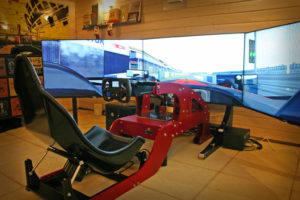By Huan Nguyen, William Davis, and Ciaran Sinclair
Formula 1 (F1) is a billion-pound sport that blends between entertainment (a show) and competition. It is arguably the most advanced, high-tech sport in the world. Each F1 team’s factory consists of 1000+ employees who works day and night to just produce two cars that only two drivers can drive them. It costs millions of pounds to produce a racing F1 car and the costs of development and operations throughout the year add up to further hundreds of millions. As many as 3000+ car parts are produced each week by each team. Teams invest heavily to just happily outpace other teams’ cars by a tenth of a second a lap when racing in a circuit of over 5km.
The two key things for a winning team: i) produce a very good racing car; and ii) be slick and efficient in operation as a team. Both of these can be decisively supported by one key technology: Digital Twin, because of its largely data-driven environment and the decision making is often made in real-time manner (in pressurised racing conditions).


Production of a good racing F1 car with Digital Twin
The goal for the F1 engineers is to design an F1 car that is glued to the asphalt (like running on rail) so that the cornering speed is very fast. However, it also needs to be efficient so that it is not draggy on the straights. These requirements make aerodynamic a crucial performance aspect of the car. From the 2021 season when the sliding scale of time allowance to use wind tunnel and the CFD is applied, the role of a good virtual design is even more important.
For cost saving, this year’s testing was limited to 3 days only. We can see that the teams needed to rely more on the digital design to allow the car to hit the ground running. However, that was not the case in the test at the Bahrain circuit (12-14th March) for the defending champion, Mercedes. The new rule was set to cut down the floor to reduce the rear downforce, somehow catching the Mercedes as their car struggled with the handling and setup. Their engineers would need to go through the massive data collected from the three days of testing to detect the issues and see where it went wrong. They would need to take into account the windy and sandstorm conditions in Bahrain, the characteristic of the new Pirelli tyres, the abrasive nature of the surface (compared to last year’s test circuit in Barcelona) in order to re-correlate their digital twin version.
Sensors for data collection
With so many parts of the car that can have impact on the overall performance, the team develops a digital twin of their car, by using the vast amount of data from testing and from actual races. The initial version of their digital twin may not be perfect, but the correlation between actual running and the output from the digital car will eventually help the team perfect their digital twin and subsequently improve their actual car design. Each racing car can have around 150-200 sensors to collect and feed live telemetry data at every 0.001s from racing circuits back to their technology quarters (mostly in the UK, except Ferrari, Alpha Tauri and Alfa Romeo). This is where their digital twin can help hugely in making the right strategy decision in a split second.
Optical slip sensors are used a lot around the cars due to their high accuracy and low latency. They are used inside tyres to measure: sidewall deformation, tread deformation, footprint contact pressure, and footprint length. These measurements are transmitted and joined with the tyre pressures, carcass, surface, ambient and track temperatures. In practise sessions and testing, IR cameras are mounted above the side pods to measure outside tyre carcass temperatures. Correlating these data will lead to a predicted wear percentage.

For a few years now, Red Bull Racing has been partnered with ANSYS and Siemens. ANSYS provide the team with their ANSYS Fluent CFD software. This allows the team to accurately model and simulate aero components without the need for extensive wind tunnel and real world testing. One of the biggest challenges in simulating aero components is physical computing power because of how complex the calculations need to be. Therefore, Red Bull use computer clusters to share the load. Along with CFD modelling, the team uses ANSYS Granta Material Intelligence to select optimal materials and ANSYS LS-DYNA to simulate crash structures. This approach allows for near perfect design simulations that require minimal real world validations which is needed to stay at the front of the field.
For the main car assembly, Siemens NX is used and allows designers perform design updates at high speed. “We have an aggressive, nonstop and increasingly complex development cycle before, during and after the season. In addition, the volume of design changes goes up year on year, with our designers making up to 1,000 changes per week between races.” – Matt Cadieux, chief information officer. In conjunction with NX, the team utilises Siemens Teamcenter to produce an event-specific Bill of Materials (BOM) for each race, and a master list for the whole season. This master BOM contains all the parts required to set up for the car for every specific race, not just materials. These BOM lists are maintained in real-time to ensure parts are managed to avoid shortages.
Data Transfer
In the 2021 rules, all cars must be fitted with a telemetry system which has been manufactured by the FIA designated supplier to a specification determined by the FIA. Pit-to-car telemetry is prohibited; therefore, all data must first pass through the FIA’s servers. This data is sent over RF with some reports of speeds of 60GHz on the start/finish straight.
Collecting high-resolution data is key to understanding how the car changes throughout a race and predicting what will happen to the car in future races. Up to 3GB of data is transmitted during a practice session, with up to 3TB of data over a race, with the ECU receiving and sending over 750 million data points.
Teams use a wide range of sensors to inform them about every aspect of the car in real-time so they can monitor its performance through specific corners and down straights. Air pressure taps in the front wing and across the bodywork enable the team’s aerodynamicists to measure aero pressure and load. Their trackside findings are fed back to the factory, where the aero team develops and builds refined components based on the comparison between expected and collected data. Particular care and attention is given to tire degradation and wear throughout the race. Running pressures and temperatures must be controlled and monitored for optimal performance as even minimal changes in these readings can indicate potential issues or the need for a tire change. Responding in real time to unforeseen events is critical in the case of potential failures.
The throttle pedal is a piece of fly-by-wire technology; its use is measured by a sensor within the garage which outputs a percentage based on the amount of depression on the pedal by the driver, where 100% is fully pressed. The driver can dial-in the power delivery through the pedal’s range to best suit their driving style and this pedal data is used to help inform that decision. Carbon-fibre brake discs operate at incredibly high temperatures, more than 1000°C. The brakes are constantly monitored to ensure they don’t overheat, and brake pressure sensors are used to customise the pre-set brake bias settings the driver has at their disposal, unique to each track. Each wheel is fitted with a sophisticated, aerodynamic brake duct which filters cooling air to the brakes.
Back at the factory, the digital twins are validated with this real data and observations, each car streams 100,000 data points a second, around 100GB of data each race and well over a billion numbers in a two-hour race. Digital twins which add virtual sensing into the mix, increase the amount of real-time data to about 5 billion numbers each race or 11.8 billion data points each year. To deal with this insane amount of data generated by the car, McLaren use a framework implementation of a software bus using stream-processing called Apache Kafka. It provides a unified, high-throughput, low-latency platform for handling real-time data feeds with trillions of events a day making it ideal for digital twin use in F1. The trackside engineers are in constant connection with a group of engineers and strategists back at the factory who analyse the data as it comes in and run simulations. Specific audio channels are left purely for off track communication to ensure clear lines of contact.
Digital Twin can help team prepare and optimise its operations:
Drivers can practise their driving and learn things in a car simulator (digital twin) before even hitting the racetracks. With testing time is limited these days to save costs, the drivers rely more on the digital version of the car and of the circuit. The more accurate of their simulator, the better the divers can prepare themselves by practising.
In F1, live decision in a split second can decide winning or losing. All the team rely on their digital twin to predict and run hundreds of different scenarios during the race, and ready for any unexpected events. Despite this, racing can still manage to throw in some events that surprise the teams.
To spot when there’s a problem on the car, there are three main sources of information: pitwall + cameras around the track, driver awareness and sensory data from sensors mounted on the car. Sensory data being fed into a digital twin will give the most insight into an issue and can usual predict a degradation of a component before failure, however, failures still do happen. Sometimes the issue is unknown or between sensors. Teams that are the closest to a ‘perfect’ digital twin will have the most reliable car. Achieving this means a high level of testing and correlating simulation data to real-world testing to understand how materials behave, minimising the possibility of problems happening where a team wouldn’t expect.

Months ahead of each race, a team of strategists begin running race simulations to refine and develop the team’s strategy for the weekend. This advance work helps with the selection of tire compounds, which must be done several weeks out from the race date, and the building of the run-plan for the weekend. Once qualifying concludes on Saturday, the grid data and lap-time values are used to create a more refined simulation, which helps the race engineers determine the best strategy for each car. As previously mentioned circumstances in the race are ever changing and sometimes strategy calls have to be made in a split second, the data gathered throughout the race up to that point can be used to better inform the pit wall and make the decision easier.
Every component of the car has a digital twin, on which simulations are run before producing the physical part. This allows the team to design new parts they were not able to design 5 years ago and run performance and reliability tests on parts in simulation before they get put on the car. These simulations can give the engineers an idea of the life span of a particular part and what might be causing the most strain on it, providing areas for improvement. One of these components is the wheel nuts, they are an essential but complex piece of machined alloy. They need to be robust and fail-safe but are constantly refined during the season as the engineers look to make them faster to remove and replace to reduce pit stop time.
DT explains why now the teams can produce car with excellent reliability record despite the testing time is limited to a minimum.
Data Security in Formula 1’ digital twin development
With the team trying everything to gain advantage over the rival teams, and with the high secrecy requirement give the high-teach nature of the sport, how the teams secure their data? Can blockchain be the answer? How do they secure their data?
Blockchain security is slowly making its way into Formula 1 since 2016, with Williams recently extending their contract with Acronis, a blockchain security company specialising in data protection, storage and backups, disaster recovery and file sharing. The team has been using the Acronis Cyber Protect software since 2020. The software uses an ‘AI-enhanced’ solution that decentralises data storage and transfer, preventing cyber-attacks and avoiding downtime.

